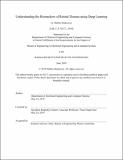| dc.contributor.advisor | Jayashree Kalpathy-Cramer. | en_US |
| dc.contributor.author | Shahrawat, Malika. | en_US |
| dc.contributor.other | Massachusetts Institute of Technology. Department of Electrical Engineering and Computer Science. | en_US |
| dc.date.accessioned | 2020-11-23T17:39:22Z | |
| dc.date.available | 2020-11-23T17:39:22Z | |
| dc.date.copyright | 2019 | en_US |
| dc.date.issued | 2019 | en_US |
| dc.identifier.uri | https://hdl.handle.net/1721.1/128573 | |
| dc.description | This electronic version was submitted by the student author. The certified thesis is available in the Institute Archives and Special Collections. | en_US |
| dc.description | Thesis: M. Eng., Massachusetts Institute of Technology, Department of Electrical Engineering and Computer Science, June, 2019 | en_US |
| dc.description | Cataloged from student-submitted PDF of thesis. | en_US |
| dc.description | Includes bibliographical references (pages 44-48). | en_US |
| dc.description.abstract | The retina has biomarkers not only for ophthalmic disease but also for diseases and conditions across the entire body. In this paper, I focus on retinopathy of prematurity (ROP), a proliferative vascular disease that can cause blindness in prematurely born infants. To prevent further disease progression and vision loss in infants with ROP, early and accurate detection of plus disease is crucial. In current practice, clinicians compare retinal fundus photographs to a reference standard image in order to detect plus disease for severe ROP. This process can be highly qualitative, subjective, and variable. Furthermore, some clinical environments may lack clinicians with the expertise to diagnose these diseases. I am to address these shortcomings in current clinical diagnosis of ROP by using deep learning methods to automatically extract biomarkers of disease without human intervention. Since ROP is primarily present in prematurely born infants, I also attempt to predict and analyze gestational and postmenstrual age, and how disease predictions vary from healthy to affected infants. | en_US |
| dc.description.statementofresponsibility | by Malika Shahrawat. | en_US |
| dc.format.extent | 48 pages | en_US |
| dc.language.iso | eng | en_US |
| dc.publisher | Massachusetts Institute of Technology | en_US |
| dc.rights | MIT theses may be protected by copyright. Please reuse MIT thesis content according to the MIT Libraries Permissions Policy, which is available through the URL provided. | en_US |
| dc.rights.uri | http://dspace.mit.edu/handle/1721.1/7582 | en_US |
| dc.subject | Electrical Engineering and Computer Science. | en_US |
| dc.title | Understanding the biomarkers of retinal disease using deep learning | en_US |
| dc.type | Thesis | en_US |
| dc.description.degree | M. Eng. | en_US |
| dc.contributor.department | Massachusetts Institute of Technology. Department of Electrical Engineering and Computer Science | en_US |
| dc.identifier.oclc | 1220877293 | en_US |
| dc.description.collection | M.Eng. Massachusetts Institute of Technology, Department of Electrical Engineering and Computer Science | en_US |
| dspace.imported | 2020-11-23T17:39:20Z | en_US |
| mit.thesis.degree | Master | en_US |
| mit.thesis.department | EECS | en_US |
